Today's painting on the easel of my deck gallery feels appropriate for these uncertain times when many people have been confined to their home in unexpected lockdown and have been rethinking many things they previously took for granted. Such as the relationship between the individual,the community and the government.
 |
Plein air painting on site with protest banner
MP22 '67 Lower Fort st - This is my home'
2014 oil on canvas 46 x 61cm
Enquiries |
What makes a house a home?
Is it just a place, or is there something a bit more intangible and numinous?
Why is where you live so important?
 |
Plein air painting on site with protest banner
MP22 '67 Lower Fort st - This is my home'
2014 oil on canvas 46 x 61cm
Enquiries |
I had been painting the East Darling Harbour Wharves for at least a decade before the development of Barangaroo so radically transformed the nature of the western side of the Sydney CBD. Long before the consequences of the end of Sydney's Working Harbour were understood by the general public, I could see the knock-on effect and how it would change the shape of people's lives.
I increasingly started to paint in the streets of the Rocks and Millers Point,knowing that the departure of the heavy industry and shipping would leave this area once again vulnerable to developers and the government. Only a couple of decades earlier, similar pressures had been faced, and the push back from an alliance of residents and unions culminated in the Green Bans led by the revered Jack Mundey AO. Some redevelopment ensued, but residents were relocated into purpose-built social housing in the Sirius Apartments, and Millers Point mostly held its ground.
But this time seemed different.
Millers Point, a historic harbourside enclave with 19th-century terraced houses is only a stone's throw from the Sydney Harbour Bridge, Walsh Bay Wharves and the former East Darling Harbour Wharves (now Barangaroo).
The grand terraces of Lower Fort Street perch on the escarpment overlooking the Walsh Bay Wharves. They spent the last century owned by the Harbour Trust in its various manifestations, and run as 'residentials' for waterside workers. The wharves, stores and workers' housing were completely integrated. The tight knit community was composed of people whose families had worked on the wharves, in some cases over 5 generations.

Plein air painting on site with protest banner
MP22 '67 Lower Fort st - This is my home'
2014 oil on canvas 46 x 61cm
Enquiries In the 1980s the Millers Point residences passed from the control of the Maritime Services Board to that of the Department of Housing and there was a noticeable decline in service, repairs and maintenance of the properties.
In
2012 the NSW government decided that almost 300 public housing
properties at Millers Point must be sold saying the revenue would
contribute to the public housing budget although how exactly the money
will be spent hasn’t yet been made transparent.
Plein air painting on site with protest banner
MP22 '67 Lower Fort st - This is my home'
2014 oil on canvas 46 x 61cm
Enquiries
|
You could easily tell which houses were still inhabited. Banners were hung over balconies, spray painted onto sheets in stencil
letters: 'Millers Point Not 4 Sale'; 'Say No to the Total Sell Off of
Public Assets'.
The ubiquitous Reg Mombassa designed protest T shirt of a skull smoking a cigar and wearing a top hat, flapped from every washing line.
I painted a series of canvases recording the protests. |
Plein air painting on site with protest banner
MP22 '67 Lower Fort st - This is my home'
2014 oil on canvas 46 x 61cm
Enquiries
|
|
The most creative protest banner was a washing line "This is my Home" on the corner of lower Fort Street and Downshire Lane in the shadow of the Harbour Bridge. It summed up every emotion and argument in a single pithy line.
As I painted this, I became friends with its author, Sally.

The artist on site with the local wildlfe
while plein air painting on site
I adore lizards, especially blue tongues, and was very happy when Sally lent me her blue tongue lizard to cuddle. To protect it from the local cats, it had a refuge in the garbage bin left lying on its side. I'd wondered why the bins were apparently scattered randomly on the tree stumps, and then realized they were lizard havens filled with rocks, food and water for 6 out of 7 days, and only used briefly for their original purpose.
I returned to paint a much larger canvas, but soon after, some low life stole Sally's T shirts. She replaced them with a set of towels with another appropriate and thought-provoking motto, "Age in place" stencilled on them.
Sally was a real character. Despite almost unbearable daily pressure from the authorities, she had the moxie to take the Government to court to try to remain in the home she had lived in for over 30 years.
Unfortunately after putting up a spirited fight, she eventually lost the case and was relocated against her will.
Related Posts
(Vanessa Berry's blog 'Mirror Sydney'- with a photo of me painting in High Street)
CLEARING HOUSE is the Tenants' Union of NSW's record of what's going on
in Social and Affordable Housing portfolio redevelopment and renewal in
New South Wales. They asked my permission to use my painting on this site.























